5-28-4 The cartoon paper is up and I'm drawing on it in chalk. There is a head board and foot board, a ventilation vent and two electrical plugins to contend with. We decided on a 1 inch white tile as a protective bumper. That is going to be the porch railing and the gate's railing, all across the mural. I need some hair spray as a fixative.
5-30-4 I'm painting 'to scale' sized acrylics, in the morning and afternoon. One from 10 in the morning to 12 and one from 1:30 to 5 in the afternoon. Both on a 15x22, 1/4 inch plywood panel with cloth glued on it before the gesso.
5-30-4, The top one I drew out with charcoal, the second with big washes of the local highlight color. With this technique you start with the big light areas and jump to the big darks. It's not as acurate. I might use this technique on the fresco if I try to do the whole top 2/3 painting in one day. That's going to be some big brushes and sponges. The first technique lends itself to giornate cuts in the fresco to paint smaller sections each day. Deep down I want to use the second technique and just cut off what I don't get to.
|
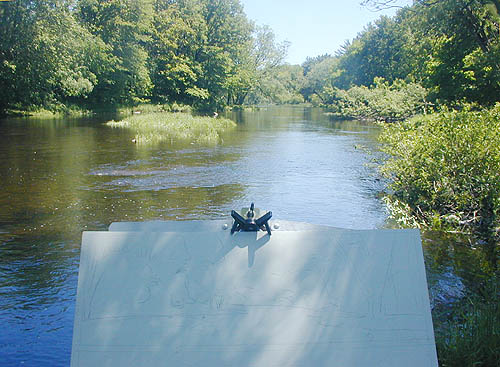 |
Drawing Day, 5-30-4, 10 AM to 3 PM. I was in omani light most of the day. By 3:00 it was raining so I didn't get to the afternoon session. This photo was taken with a 55 degree lens camera, the drawing is closer to 75 degrees. To paint 75 degrees you must move your head and have two centers. One for each 60 degrees, the amount you can see without distortion.
|
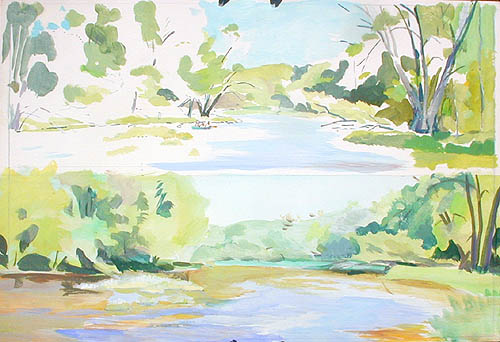 |
Day 1, 5-31-4, 10 AM to 3 PM. |
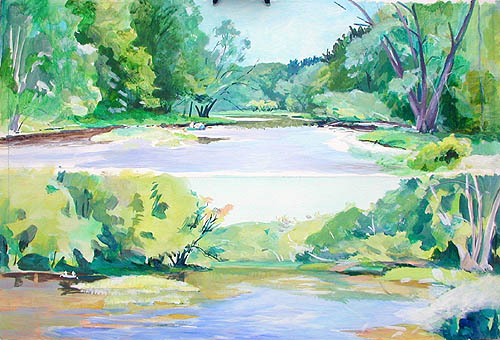 |
Day 2, I put down a lot of paint today, This is to scale, minus 1/2 inch on the sides, 1/4 inch off the top and bottom and 1/2 inch in the middle. |
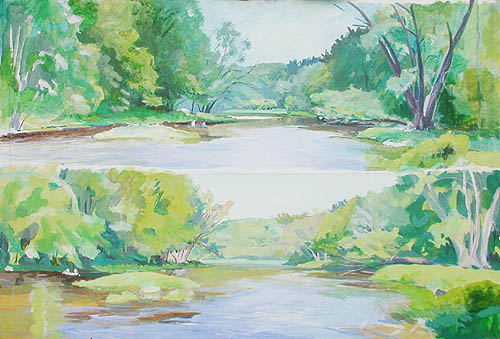 |
Day 3, 5-1-4, Today was beautiful. I saw a Red Winged Blackbird, a 3 foot tall blue 'mud hen' egret crane, a muskrat, 30 geese that looked like Hawaii's Ne Ne Bird and three mallard ducks. The sun was fogged in early this morning. The morning painting is from 10 to 1. By ten everything was perfect. The background 1/8th mile away was three basic colors, transparent Thalo turquoise, transparent Dioxin purple and hansa yellow, plus white. |
| The morning painting uses raw umber, the afternoon uses burnt umber, yellow medium azo and cadmium yellow light. Orange, red and magenta are not in the morning painting except as neutralizers for the cyan-green, cyan and cobalt blue hues.
Neither painting is 100% covered yet, that's my bench mark for being 1/2 done. |
Day 4, 5-2-4, Rain. Last night I made a test with the white small sand and lime. To see how white the mortar will dry and to practice some marble faux strokes. I tried making little size colored bits of pigment and mortar and smoothing them in but it took too many strokes to smooth it out and I didn't get the effect I wanted. I'll try it again. I'll try spreading the pigment in lime paste on an already smooth intonaco and brush in some strokes. Tomorrow John will pick up some marble samples so I can be a little more accurate. I think I found a use for indanthrone blue. It's an awkward color, in lime it sets as ultramarine dark, permanent. |
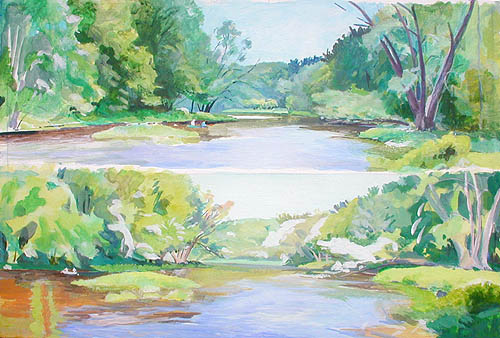 | Day 5, 5-3-4, Beautiful morning! I didn't get to work the morning picture but I did have time to do white correcting on both. It takes two coats of jar white acrylic to cover a background. I sanded down the whole panel with a 300# grit wet-dry sandpaper, just lightly to remove any uneven built up paint. I like a very smooth finished painting, always have.
|
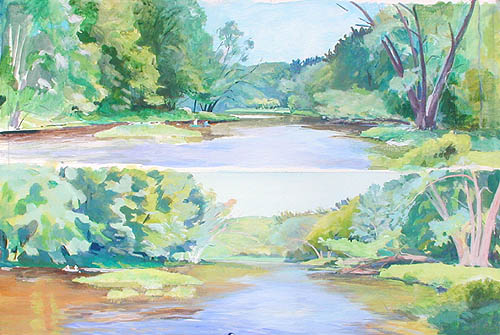 |
Day 5, Afternoon. This was a day of many shape and shadow changes. I filled in this morning's white corrections and made a lot more. I want the time later in the day so there is a bigger color change. |
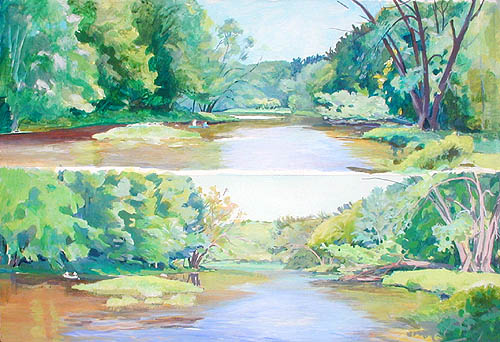 |
Day 6, 6-6-4, The morning painting is now from 9AM to 11 AM. It was a great day and I got a lot done. Thalo turquoise represents the cool of the Pigment Color Triad, it's a warm cyan. The bright leaf reflections have this tint, the shadows are loaded with it, the dark glazes are done with it. For green, a dark yellow is added. That would be yellow oxide. Yellow gets browner as it gets darker. Burnt umber is a warm yellow, raw umber is a cool yellow. Liquitex Magenta PR:122 is still my acrylic magenta pigment. It's an excellent primary pigment. |
Day 6, 5:00 to 7:00 is the afternoon painting. It went very well. Yesterday I had the wind coming from my back and it was turning the underside of leaves. That was showing a more reflective surface and it was reflecting the color of the sky. It was easy to tone down the cyan tint with a wash of Naples yellow, cadmium yellow light and Thalo blue. The tree in the left middle ground changed from being sunlit to in the shade. I have shifted my painting time two hours later to get more contrasts. |
Day 7, Saturday, 9:00 to 11:00. Another perfect day for painting. I got back to basics with color still using Thalo turquoise as the warm cyan, PR:122 Liquitex Magenta, hansa yellow, naples yellow, yellow ocher and raw umber. Other colors in play are dioxine purple, cobalt blue, cad red light and burnt sienna. Now that I have the time down to 2 hours I can adjust the shapes and modify the underlaying colors. I lowered the river in the left foreground. In the right foreground there are still white chalk outlines where tomorrow I will change the shape of the clump of foledge. Now I have 5 hours to lay mortar on the fresco, before the afternoon painting.
|
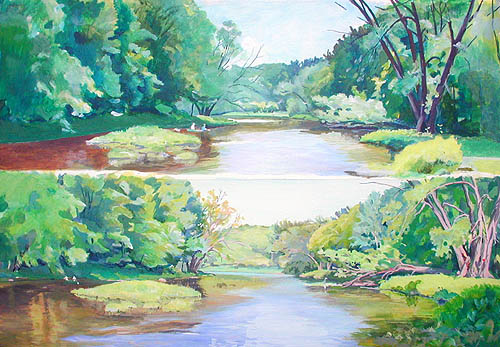 |
Day 8, 6-6-4. This morning I made some pattern shape changes, took out the middle ground tree and re-positioned it. Took out all orange references, it's really a 10:00 AM cool painting. 5:00, The sun was very inconsistent this afternoon, it was good for finding lost branches, pattern outlines and filling changed white areas.
|
Day 9, 6-7-4. Morning, it's so good being a short walk from your paintings. And to just leave everything set up for the second session. Knowing the exact time to start and stop also makes everything perfect. Today I again changed the whole atmosphere, the sky was orange-pink, the reflections were orange-pink and the opposite color is the color of the trees, a deep turquoise. Opposite in color and chroma, mass-tone and top-tone tint.
Day 9, Afternoon. Cloud coverage, no painting. I worked on the mortar and pigments painted with alcohol medium, tests. |
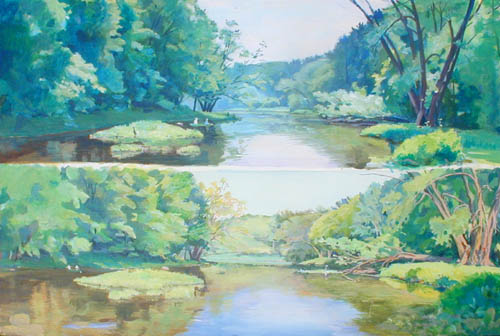 |
Day 10, 6-8-4
|
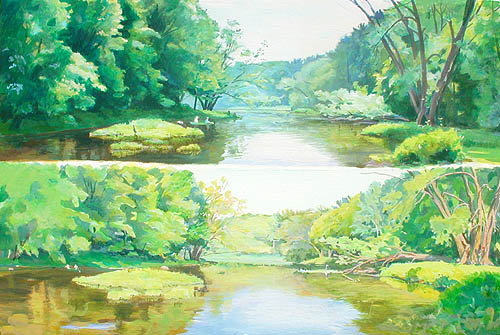 |
Day 11, 6-9-4
|
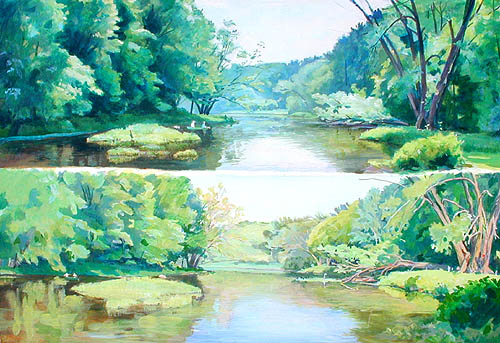 |
Morning, I made some color wash changes and some correct colors in the darkest darks.
|
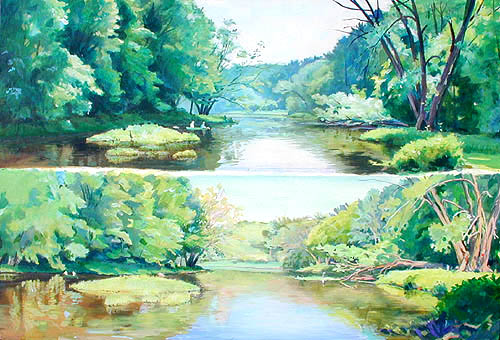 |
6-11-4, Friday Morning, day 13. Perfect weather, for continuing the painting. The two hours went quickly. Inside the house I squared up the painting, the 2'x4' fresco model, and now am ready to put the Brown coat on the 7'x13' fresco. I hope it goes faster than the Rough coat! It looks like it's going to be a good afternoon of painting also. Friday afternoon painting. I made up one of the two days I missed on location. |
The alcohol and limewater tests are dry, Thalo blue with limewater is the dark end of thalo blue, where it turns to a dark ultramarine blue, RCW#25.0.6 transparent. Painted with alcohol as the medium gives me the cyan PB15 hue, RCW#25.0.3 It also gives me that green-gold hue when mixed with Indian Yellow PY153 dioxine nickel complex, RCW#36.3 transparent.
|
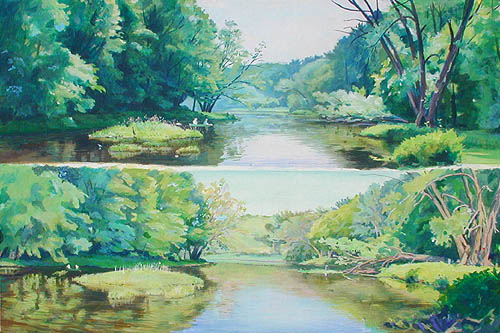 |
6-12-4, Day 14.
This afternoon painting is still one day behind the morning scene, but it's catching up on time. The choice is getting harder each day. |
The Isaby's #8-10-12 pointed liner is a 'must have' brush, able to do broad sweeps with it's length and fine detail with it's long point. This brush should not be setup for small applications of color. Rather, it's used for major and minor washes and opaque colors. Because.. the brush should be fully loaded to get correct performance. |
6-13-4, Day 15. I painted the first giornate section on the 12x24 panel. And finished the brown coat on the wall. TIP: Earlier I mentioned about having to turn my head to see the whole view indistorted. Here is a tool that helps. The WC40 Watercolor Easle. it swivels the support. I swivel the painting in the direction toward whatever I'm paintng. |
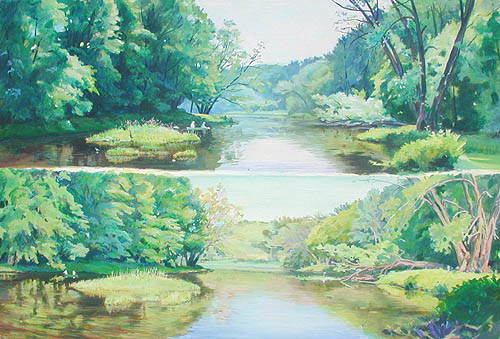 |
6-15-4, Painting Day 16. start day 17
|
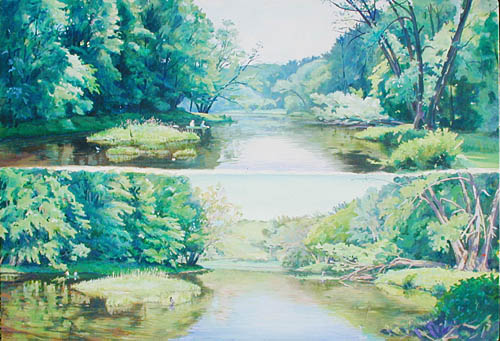 |
6-16-4, Painting Day Morning, I enhanced the direction of the sun making shadows. A shadow of a stick upright in the ground will have the tip of the shadow and the tip of the stick lining up to the sun, no matter where it is in the picture.
|
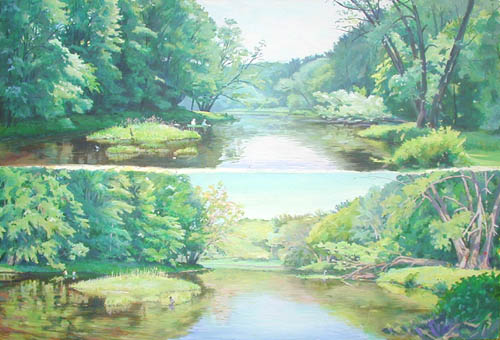 |
6-19-4, Raining. Here is what the acrylic looks like. The left top of the morning painting is finished enough for the main mural's first giornate area. |
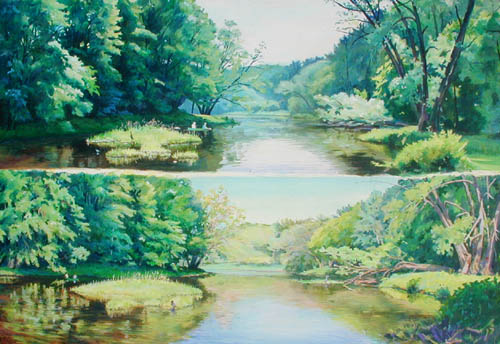 |
6-20-4, I think I'm finished. Maybe.. It's a much harder mural choice now. |
|
6-23-4, Finished. My covered flip palette was still the working palette. I sprayed water each time I started or stopped painting.
Now.. which one to use for the mural, the morning..  Or the evening..  |
NEXT FRESCO PAGE, #50 12x25 scale model fresco. fresco1mexico12x25.htm
PREVIOUS FRESCO PAGE, #48 Little Salmon River tile fresco with w/c pigments. fresco1littlesalmon.htm